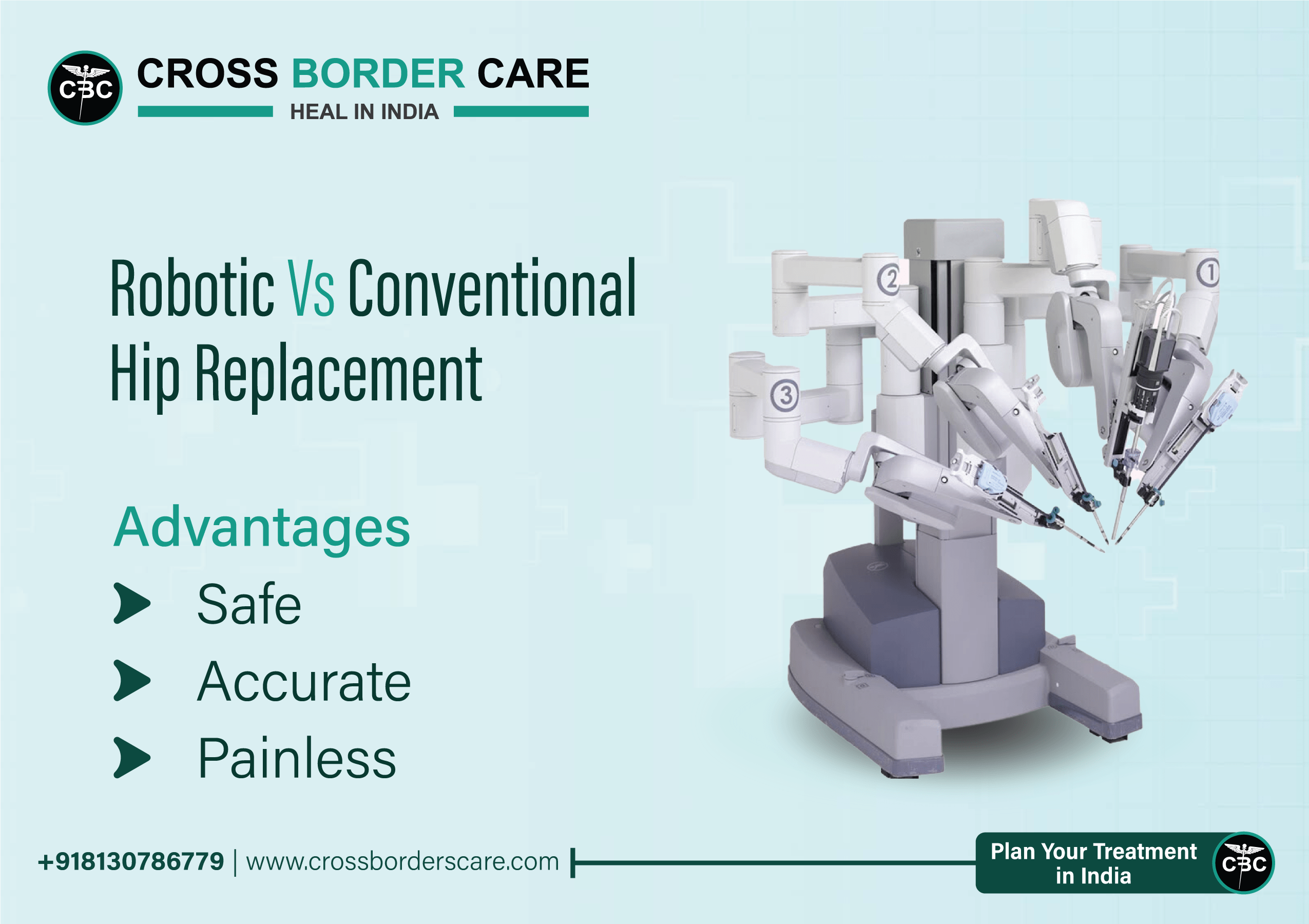Hip surgery is a challenging and highly specialized area of orthopedics that focuses on the identification and management of diseases, injuries, and conditions that affect the hip. The results and recovery time for hip surgery patients have significantly improved over time thanks to improvements in medical technology, surgical procedures, and implant materials. Robotic surgery has developed as a breakthrough method for several medical procedures and hip surgeries are one area where robotic surgery has had a significant impact. The standard treatment for hip problems and joint replacements has been traditional hip surgery. In this blog we will find out major differences between Robotic v/s Conventional Hip Surgery.
The field of hip surgery has significantly changed since the introduction of robotic-assisted surgery. Advanced imaging technologies, specialized tools, and robotic assistance are all used in robotic hip surgery to increase surgical accuracy and enhance patient outcomes. This introduction intends to delve into the fundamental distinctions between automated and conventional hip surgery, analyzing the advantages, difficulties, and potential repercussions of this ground-breaking surgical method.
Conventional Hip Surgery
The following essential steps make up the typical hip surgery process, often known as open hip surgery or conventional hip surgery.
- Anesthesia: To keep the patient unconscious and pain-free throughout the procedure, anesthesia is administered to the patient.
- Incision: To access the hip joint, the surgeon typically creates a significant incision along the side or rear of the hip.
- Dissection: The hip joint is exposed by carefully dissecting the muscles and fatty tissues that surround it.
- Joint Preparation: The acetabulum (the pelvic socket) and femoral head (the ball-shaped top of the thigh bone) are removed together with any other sick or damaged components of the hip joint. Bone saws and drills are examples of specialized surgical tools that are used for this process.
- Implant Placement: A prosthetic implant is put into the ready-made bone surfaces. These implants are often constructed of metal, ceramic, or a combination of materials. A stem that is put into the femur and a socket that is secured into the acetabulum make up the implant.
- Closure: The surgeon stitches the muscles, tendons, and other soft tissues back into their original places after making sure the implants are positioned correctly and are stable.
- Recovery: The patient is brought to a room where they will be closely watched. The goal of physical therapy and rehabilitation programs is to improve mobility, build muscle strength, and speed up the healing process. These programs are frequently started soon after surgery.
Robotic Hip Surgery
As a patient if you do comparison between Robotic v/s Conventional Hip Surgery then robotic hip surgery has a number of benefits, including enhanced surgical precision, smaller incisions, less blood loss, quicker recuperation, and maybe better outcomes. Here is a description of the robotic hip surgery procedure:
- Preoperative Planning: To develop a 3D model of the hip joint, the patient has a thorough imaging examination, such as a CT or MRI, before the procedure. The surgical process is planned using this digital model, which is also utilized to tailor where the implants will be placed.
- Patient Preparation: To ensure comfort and pain management throughout the treatment, the patient is put under anesthesia, often general anesthesia.
- Placement of the Robotic Arm: The robotic arm is placed close to the patient’s hip joint. An HD, enlarged picture of the surgical site is made possible by the arm’s combination of specialized surgical tools and a camera.
- Registration and Mapping: The surgeon integrates the patient’s anatomy with the robotic system using the 3D model made from preoperative imaging. As a result, the robot can precisely track the patient’s motions and support the surgeon’s in-procedure in real-time.
- Small robotic incisions: Small incisions, usually 1-2 inches long, are used to access the hip joint in minimally invasive procedures. Compared to conventional surgery, these incisions are smaller, which minimizes tissue damage and lowers the chance of problems.
- Robotic Support: The robotic system helps the surgeon steer the surgical tools with the maximum accuracy. To ensure precise bone preparation, implant placement, and soft tissue management, the robot offers real-time feedback, including visual and haptic feedback.
- Placement of Implant: Using a robot, the surgeon carefully removes the hip joint’s damaged areas and prepares the bone surfaces for the implant.
- Closure and Recovery: The incisions are stitched or stapled shut after the implants have been firmly inserted. The postoperative phase, which usually entails physical therapy and rehabilitation to regain strength, mobility, and function, is progressively introduced to the patient while they are being watched in the recovery area.
Which one is Better?
- Surgical Precision and Accuracy: Thanks to their cutting-edge imaging capabilities and real-time feedback, robotic systems offer improved precision and accuracy. According to preoperative planning, the robotic arm helps the surgeon carry out precise movements and implant placement, potentially improving outcomes. Despite the fact that traditional surgery depends on the expertise and experience of the surgeon, it might not be as precise and accurate as robotic surgery.
- Tissue Trauma and Incision Size: Robotic surgery is frequently associated with smaller incisions, typically between one and two inches, resulting in less tissue trauma. Reduced pain, shorter hospital stays, and quicker healing times may result from smaller incisions. Larger incisions used in conventional surgery may result in more tissue harm, more discomfort, and longer recovery times.
- Blood Loss and Transfusion Rates: Robotic-assisted techniques offer the potential to minimize blood loss during surgery. Robotic technology enables precise control, minimizing blood vessel damage, and lessening the requirement for blood transfusions. In difficult circumstances or in patients with underlying diseases, conventional surgery may result in greater blood loss, which may require blood transfusions.
- Hospital Stay and Recovery Time: Due to less tissue stress, less discomfort, and quicker recovery times, patients who have robotic surgery frequently have shorter hospital stays. Additionally, they could need less post-operative rehabilitation. Traditional surgery often includes more extended hospital stays, averaging several days, as well as a more extended recovery period that may include more intensive rehabilitation.
- Scar Formation and Aesthetics: Robotic surgery may produce smaller, more aesthetically acceptable scars due to the use of smaller incisions. Patients who are worried about obvious scars may find this to be very attractive. In traditional surgery, larger incisions frequently result in more pronounced scars, though the final look might vary based on a number of factors.
- Surgeon Experience and Learning Curve: In order, for surgeons to use a robotic system efficiently, robotic surgery requires specialized training. The learning curve might be challenging, but after becoming adept, the surgeon can benefit from the technology’s benefits and precision.
Traditional surgery is a well-established practice, and open surgical specialists have developed their abilities over time.
It’s crucial to remember that while robotic hip surgery may have benefits like improved precision and smaller incisions, it might not be appropriate for all individuals. When choosing the best surgical strategy, a number of factors, including cost, the availability of robotic equipment, patient-specific traits, and surgeon skill, are important considerations.
In the end, the decision to have Robotic v/s Conventional Hip Surgery should be based on the patient’s specific requirements, the severity of the condition, and the surgeon’s suggestion. Finding the best course of action for the best results will depend upon your consultation with an orthopedic specialist. If you want more such comparisons, stay tuned for our next blog.
May 15, 2023



















